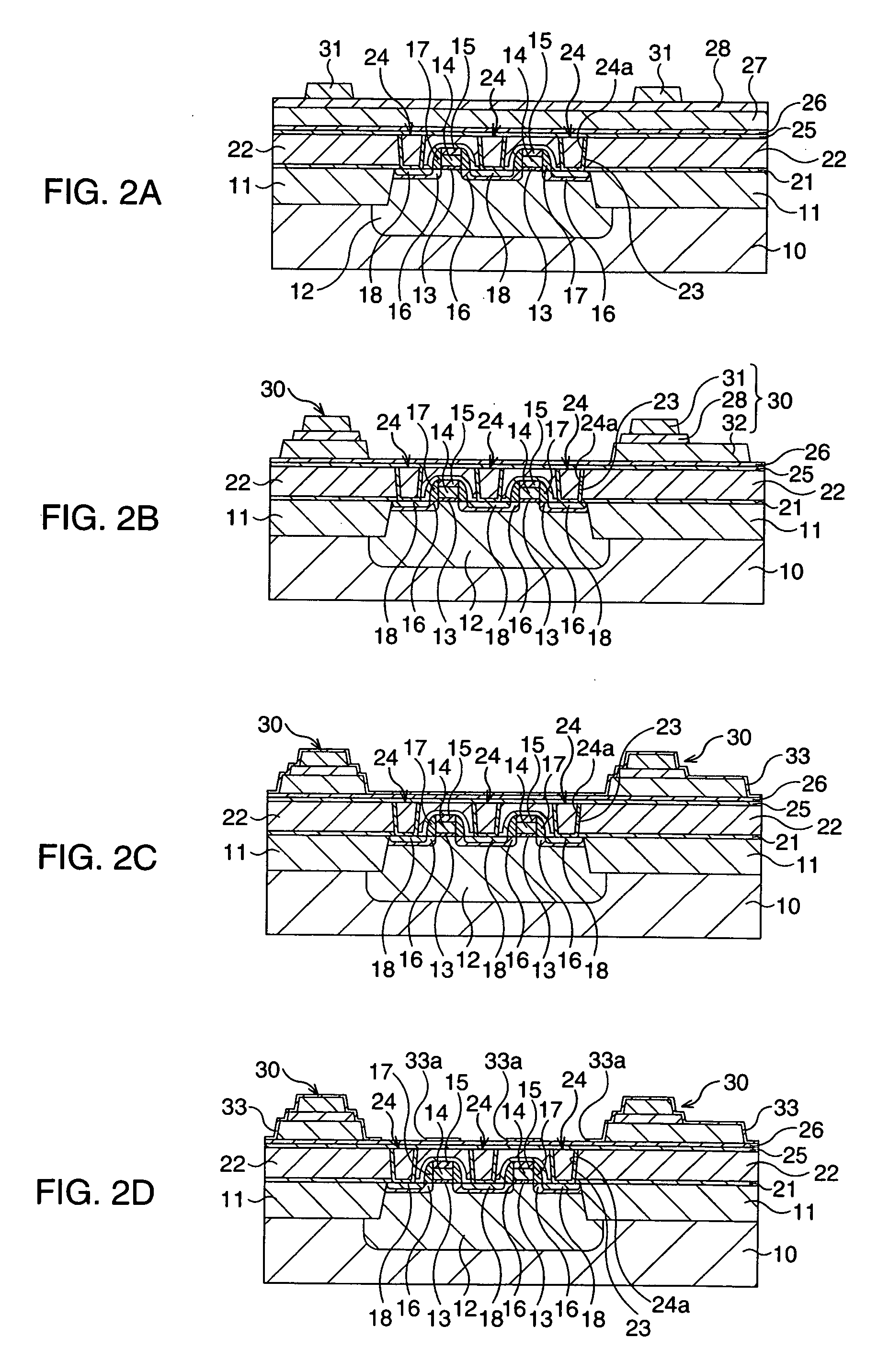Semiconductor device and fabricating method of the same
a semiconductor and capacitor technology, applied in semiconductor devices, capacitors, electrical devices, etc., can solve the problems of preventing reliable electric connection, difficult to form connecting holes for establishing electric, and requiring relatively high voltage, so as to reduce poor contact, reduce poor resistance, and suppress degradation of capacitor characteristics.
- Summary
- Abstract
- Description
- Claims
- Application Information
AI Technical Summary
Benefits of technology
Problems solved by technology
Method used
Image
Examples
first embodiment
[0061]FIGS. 1A to 4B are schematic cross sectional views illustrating the fabricating method of a ferroelectric memory according to the present embodiment, in the order of the processes.
[0062] At first, as illustrated in FIG. 1A, MOS transistors 20 which function as selection transistors are formed on a silicon semiconductor substrate 10.
[0063] More specifically, a device separation construction 11 is formed by a STI (Shallow Trench Isolation) process, for example, on the surface layer of the silicon semiconductor substrate 10 to define a device activation region.
[0064] Subsequently, an impurity is implanted into the device activation region to form a well 12. In this case, B is implanted into the device activation region by ion implantation with a dose amount of 3.0×1013 / cm2 and an acceleration energy of 300 keV.
[0065] Then, a thin gate insulating film 13 with a thickness of about 3.0 nm is formed on the device activation region, for example, by thermal oxidation. Then, a polyc...
first modified embodiment
[0119]FIG. 10 is a cross sectional view for describing main processes of the present modified embodiment which are particularly different from those of the first embodiment.
[0120] In the present modified embodiment, similarly to in the first embodiment, firstly transistor constructions 20, first plugs 24, ferroelectric capacitor constructions 30 and a first protective film 33 are formed and, after the formation of them, the state of FIG. 10A corresponding to FIG. 2C is reached.
[0121] Subsequently, as illustrated in FIG. 10B, the first protective film 33 is processed.
[0122] More specifically, the first protective film 33 is processed by lithography and subsequent dry etching such that island-shaped portions of the first protective film 33 covering only the ferroelectric capacitor constructions 30 are left. At this time, the first protective film 33 is made to cover only the ferroelectric capacitor constructions 30 and the portions of the first protective film 33 lying over the fir...
second modified embodiment
[0133]FIG. 12 is a schematic cross sectional view for describing main processes of the second modified embodiment which are particularly different from those of the first embodiment.
[0134] In the present modified embodiment, similarly to in the first embodiment, firstly transistor constructions 20, first plugs 24, ferroelectric capacitor constructions 30 and a first protective film 33 are formed and, after the formation of them, the state of FIG. 12A corresponding to FIG. 2C is reached.
[0135] Subsequently, as illustrated in FIG. 12B, the first protective film 33 is processed.
[0136] More specifically, the first protective film 33 is processed by lithography and subsequent dry etching such that island-shaped portions of the first protective film 33 covering only the ferroelectric capacitor constructions 30 are left. At this time, the first protective film 33 is formed to have a size covering only the ferroelectric capacitor constructions 30, so to say, redundantly, namely a size on...
PUM
 Login to View More
Login to View More Abstract
Description
Claims
Application Information
 Login to View More
Login to View More - R&D
- Intellectual Property
- Life Sciences
- Materials
- Tech Scout
- Unparalleled Data Quality
- Higher Quality Content
- 60% Fewer Hallucinations
Browse by: Latest US Patents, China's latest patents, Technical Efficacy Thesaurus, Application Domain, Technology Topic, Popular Technical Reports.
© 2025 PatSnap. All rights reserved.Legal|Privacy policy|Modern Slavery Act Transparency Statement|Sitemap|About US| Contact US: help@patsnap.com



